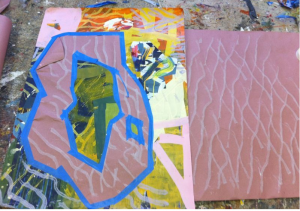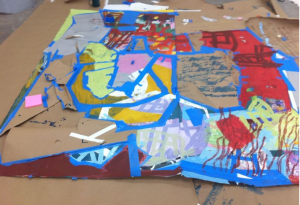This set was made during my Paducah Artist in Residence in Kentucky.
Process: Masks
In this set of paintings I use a variety of masks, stencils and resists . I consider anything that resists the application of paint a useful tool in my improvisational process. Brian Eno, in his interview with NPR, spoke about one of the most inherent problems of improvisation: every one plays all the time. No one shuts up. I use masks to provide relief to this problem. Masks help me quite area, so other areas can be developed further.
In my smaller work, I use Scotch-Blue for delicate surfaces (orange label, painters tape) that is removable up to 60 days. I prefer to use 2 inch width so I can cut it into unusual shapes and edges. I also use Mylar stencils when I silkscreen on the surface. I work these both the tape and stencils together to maximize unusual results.
In the larger work, I have started to use brown butcher paper to cover areas that I want to protect from marks and foot prints. As I paint on the the floor, I have to walk across the paintings to get to other areas. I use 1″ painters tape to seal the edges of the butcher paper as well as a coat or two of GAC 500 to protect the tape. I also add a generous butcher paper border to the edges to extend the outer area of drawing. This helps me to paint without restriction up to and over the edges of the painting. I find that this kind of extension keeps my corners from visually collapsing and provides unpredictable and spatial corners.
In the final stages of the painting, I will use neon post-it notes to mask off delicate and very small areas. I call this “mending”. The post-it note’s adhesive is less likely to tear the paint off the paper when it is removed. It also functions to highlight the small areas, and thus I am less likely to smudge or step in them by accident.

